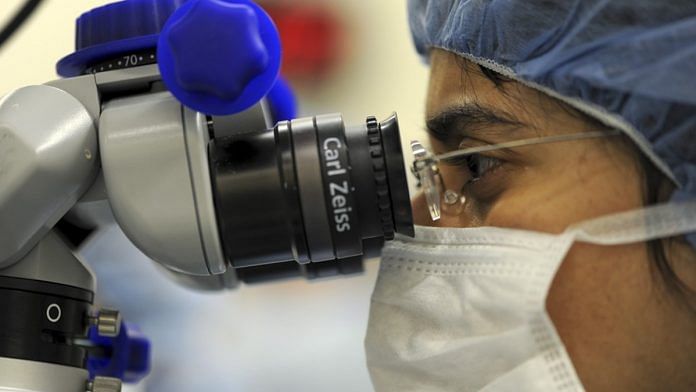New Delhi: Assam’s Nagaon district is home to the world’s largest visually challenged family. As many as 18 members of a family, running across four generations, are visually challenged.
The condition caught the attention of health experts, who have now found that a hereditary disorder is behind this. A mutation of the GJA8 gene has been causing continual deterioration of the optic nerve in the family.
Doctors investigating the case told The Times of India that there are only four such families in the world. The other three were discovered by the University of Sydney Genetic Laboratory.
“Now that the cause has been identified, every pregnancy should be tested for the presence of the gene. If found, they will have to go for termination as per law. The selection of unborn members will gradually reduce the burden and after a few decades, the defect will disappear,” said Dr Gayatri Gogoi, principal coordinator of the project and an assistant professor of pathology.
The family had, in fact, recently terminated a pregnancy after they discovered the presence of the gene in the foetus, the doctor said.
The project to identify the cause of blindness in the family, which survives on begging, began in February 2018. “When I came to know about the family, I explored that it must have a hereditary mystery,” Dr Gogoi said.
Also read: Rare tea variety from Assam fetches record Rs 75,000 per kg at auction
Manipur civil engineer builds museum to preserve WWII relics
Arambam Angamba Singh, a civil engineer from Manipur and a self-taught military history researcher, has built a private museum in Imphal to preserve relics from the 1944 Battle of Imphal-Kohima, during World War 2.
Singh and his team of volunteers collected over 200 objects, such as helmets, bayonets, water canteens, spent grenades, medals, gas masks and artillery shells over the past seven years.
They were recovered from places such as Nungshigum, Kanglatongbi, Shangshak, Tengnoupal and Bishenpur in Manipur, which were all battlegrounds during the Imphal-Kohima war.
While Singh keeps some of the recovered objects in his private museum, others are kept at the Imphal Peace Museum.
“I once found a family photograph of an unknown Japanese soldier. That kind of thing stays with you. I wonder from time to time if he ever got back home,” Singh said, Hindustan Times reported.
He also launched the ‘Battle Tours’, which are trips to a range of these former battleground sites. Most of his bookings come from foreigners whose family members fought in the war.
Also read: Extortion notices demanding Rs 200/house reach Tripura-Mizoram border village, 18 yrs late
After cookies and rice, Tripura now launches bamboo candles
Keeping with the Diwali spirit, Tripura Chief Minister Biplab Deb Friday launched a range of bamboo candles from the state. Tripura had earlier introduced bamboo cookies and bamboo rice.
During the launch, Deb said these eco-friendly candles will cut down on environmental pollution and also provide employment opportunities to local artisans.
“Bamboo is a unique sector and very crucial to Northeast India which can generate employment. It is eco-friendly and the muli variety of bamboo grows abundantly and fast. PM Modi approved bamboo to be treated as grass instead of trees so that employment is generated,” he told reporters.
The candles consist of shells that can be used multiple times, reducing the use of plastic and other non-biodegradable products.
Assam switch costly onions for traditional spice blend
Prasanta Phukan, a BJP MLA from Assam’s Dibrugarh district, has a unique solution to tackle the rising vegetable prices — use ‘paachphuran’, a mix of five spices used in traditional cuisine, as a substitute for costly onions.
Phukan said the ingredients in paanchphuran, which includes fenugreek (methi), are good for health.
“Right now, people should not worry about the prices of onions. Instead of Onions the people can use ‘paanchphuran’ as a substitute. In rural areas, people often use ‘paanchphuran’ instead of onions,” he reportedly said.
“To cook chicken, people in rural areas use two onions whereas people in urban areas need 1 kg onions to cook food. In a month, about 2-2.5 kg of onion is required in a household,” he explained.
Vegetable prices have shot up in Assam in the past few weeks, with Chief Minister Sarbananda Sonowal ordering teams to check the sudden inflation.
Also read: An NGO is offering food to stranded truckers along Assam-Mizoram highway amid border row






